Low Refractive Index
November 16, 2015
I just got a new pair of
eyeglasses. Unlike my old pair, which used
lenses ground from
glass, this new pair has
plastic lenses. Although I don't know the specific plastic used for the lenses,
polycarbonate is representative of such
materials, and it has a low
density (1.22
g/
cc) with a high
refractive index (1.585) that makes it easier to
figure a lens.
Optical crown glass, a traditional lens material, also has a high refractive index (1.523), but it's much heavier, having a density of 2.55 g/cc. My new eyeglasses are much lighter than the old, since the density of the plastic is half that of glass. My new eyeglasses have
progressive lenses, a
bifocal lens technology with a smooth transition between distance and reading aspects.
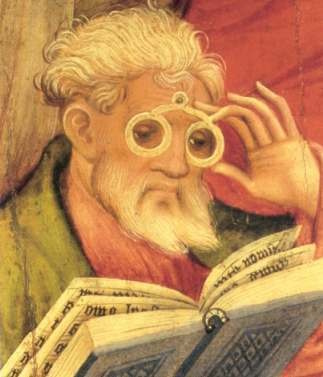
Optical lenses have been known from antiquity, but the apparent first mention of their use as a corrective lens is in Pliny the Elder's description of an emerald as a vision aid.[1]
(The Glasses Apostle, a 1403 painting by Conrad von Soest (c. 1730 - c. 1422), considered to be the oldest depiction of eyeglasses north of the alps, via Wikimedia Commons.)
While high refractive index is useful for lens making, low refractive index optical materials are also useful.
Optical fiber is an example of an optical element combining a low refractive index material with high refractive index material. Two useful optical elements making use of both low and high refractive index materials are the
dielectric mirror and the
dichroic filter.
Whenever
light passes through an interface of one refractive index to another, a portion of the light will be
reflected, and the rest will be transmitted. By selecting the thickness of multiple refractive layers, the reflected rays can be selected to
interfere constructively or destructively at certain
wavelengths. This is an optical manifestation of
Bragg's law.
Modern
material deposition techniques make it easy to produce optical films of many layers. I designed a
bandpass filter for the
helium-neon laser wavelength (632.8 nm) using alternating layers of materials with refractive indices of 1.49 and 2.38. This filter has 40 double layers with a layer thickness of 106.17 nm for the lower refractive index and 66.47 nm for the higher refractive index. The filter response at
normal incidence is shown below.
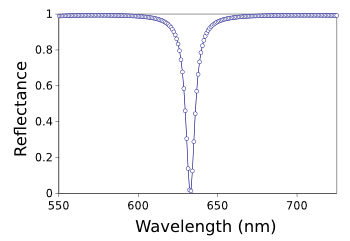
Optical response of a bandpass filter designed for the 632.8 nm helium-neon laser wavelength. This filter has eighty layers of alternating low and high refractive index.
(Graphed using Gnumeric.)
The lowest refractive index is 1.0, the refractive index of the
vacuum, but the refractive index of
air, about 1.0003, is close enough to one that 1.0 is often used in calculations. When an air gap is formed between two
parallel plates of high refractive index, this
Fabry–Pérot etalon will cause an
interference pattern through
constructive and destructive interference of light waves of a particular wavelength. Although any interface between media of different refractive indices will lead to
reflection (4% in the case of
window glass), such etalons perform best with partially-transmitting
mirrors (see figure).

A Fabry–Pérot etalon and its interference pattern.(Created using Inkscape.)
Construction of an air gap between parallel plates is easy when the plates are thick, like
microscope slides. Thin plates would likely
deform, so the parallelism is destroyed. It would be far easier to work with an optical material with a refractive index very close to 1.0.
That was the motivation for recent
research by
scientists from
North Carolina State University (NCSU, Raleigh, North Carolina) and the
Air Force Research Laboratory (Dayton, Ohio). In a recent
paper in
Advanced Functional Materials, they describe a
nanolattice material with a refractive index as low as 1.025.[2-3] As is typical in
science, this recent advance is built on a previous process, developed by the NCSU scientists last year.[4-5]
The NCSU process creates a sea of
self-assembled colloidal particles on surfaces. In last year's study, such an assemblage was placed on a
photosensitive layer to act as lenses for selective exposure.[4-5] Says
Chih-Hao Chang, an
assistant professor of
mechanical and aerospace engineering at NCSU,
"We are using the nanosphere to shape the pattern of light, which gives us the ability to shape the resulting nanostructure in three dimensions without using the expensive equipment required by conventional techniques... and it allows us to create 3-D structures all at once, without having to make layer after layer of 2-D patterns."[5]
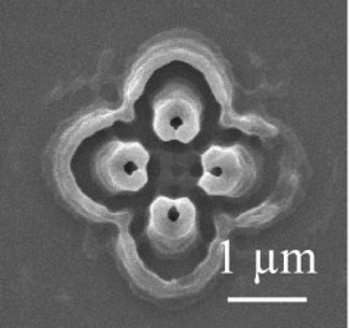
An example of an asymmetric hollow-core three-dimensional nanostructure fabricated by shining light through a surface nanoparticle lens array.
(NCSU image by Xu Zhang.)[5)]
The surface nanoparticles were used to create ordered nanostructured layers in a different way to create the low refractive index films. The surface array acts as a
template for formation of a thin layer of
aluminum oxide by
atomic layer deposition (ALD). The polymer surface array is then
burned off, and a three-dimensional aluminum oxide coating is left behind.[3]
Explains
Xu Zhang, lead author of the recent paper and a
Ph.D. student at NCSU,
"The key to the film's performance is the highly-ordered spacing of the pores, which gives it a more mechanically robust structure without impairing the refractive index. We are able to control the thickness of the aluminum oxide, creating a coating between two nanometers and 20 nanometers thick... Using zinc oxide in the same process, we can create a thicker coating. And the thickness of the coating controls and allows us to design the refractive index of the film."[3]
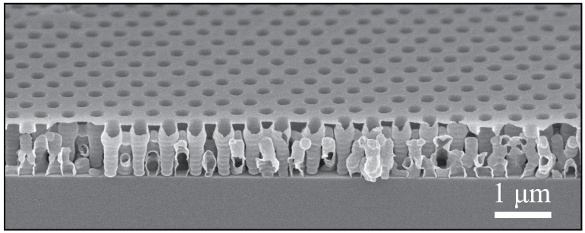
The structure of a nanostructured dielectric film at the micrometer scale. (NCSU image by Chih-Hao Chang.)
The research team has developed a
mechanically stiff aluminum oxide film with a refractive index of 1.025.[3] Aside from optical applications, these films can serve as
electrical insulators in
high speed interconnections in
integrated circuits. Says Chang, "The steps in the process are potentially scalable, and are compatible with existing chip manufacturing processes... Our next steps include integrating these materials into functional optical and electronic devices."[3]
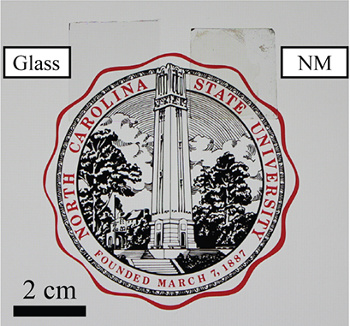
This photograph compares the transparency of the low refractive index films (NM) with glass.
(NCSU image by Chih-Hao Chang.)
![]()
References:
- Pliny the Elder, "The Natural History," John Bostock, Trans., Book 37, Chap. 16 ("Smaragdus"), via Project Perseus.
- Xu A. Zhang, Abhijeet Bagal, Erinn C. Dandley, Junjie Zhao, Chrisopher J. Oldham, Gregory N. Parsons and Chih-Hao Chang, "Ordered Three-Dimensional Thin-Shell Nanolattice Materials with Near-Unity Refractive Indices," Advanced Functional Materials, October 12, 2015, doi: 10.1002/adfm.201502854.
- Matt Shipman, "Dielectric Film Has Refractive Index Close to Air for Photonics Applications," North Carolina State University Press Release, October 12, 2015.
- Xu A. Zhang, Bin Dai, Zhiyuan Xu and Chih-Hao Chang, "Sculpting Asymmetric Hollow-Core Three-Dimensional Nanostructures Using Colloidal Particles," Small, December 8, 2015, DOI: 10.1002/smll.201402750.
- Matt Shipman, "Nanoparticle Allows Low-Cost Creation of 3-D Nanostructures," North Carolina State University Press Release, December 8, 2014.
Permanent Link to this article
Linked Keywords: Glasses; eyeglasses; lens; fabrication and testing of optical components; grinding; glass; plastic; polycarbonate; material; density; gram; cubic centimeter; cc; refractive index; figuring; optics; optical; crown glass; progressive lens; bifocals; bifocal lens; technology; hHistory of optics; antiquity; corrective lens; Pliny the Elder; emerald; visual perception; vision; Conrad von Soest (c. 1730 - c. 1422); Alps; Wikimedia Commons; Optical fiber; dielectric mirror; dichroic filter; light; reflection; reflect; interference - wave propagation; wavelength; Bragg's law; material deposition; bandpass filter; helium-neon laser; normal incidence; Gnumeric; vacuum; air; parallel; Fabry–Pérot etalon; interference pattern; constructive and destructive interference; window glass; mirror; Inkscape; microscope slide; plasticity; deformation; research; scientist; North Carolina State University (NCSU, Raleigh, North Carolina); Air Force Research Laboratory (Dayton, Ohio); academic publishing; paper; Advanced Functional Materials; crystal structure; nanolattice; science; self-assembly; self-assembled; colloid; colloidal; photolithography; photosensitive layer; Chih-Hao Chang; assistant professor; mechanical and aerospace engineering; asymmetry; asymmetric; pattern; template; aluminum oxide; atomic layer deposition; pyrolysis; burn off; Xu Zhang; Doctor of Philosophy; Ph.D.; postgraduate education; mechanical; resilience; robust; zinc oxide; micrometer; stiffness; mechanically stiff; electrical insulator; super high frequency; high speed; integrated circuit; transparency.